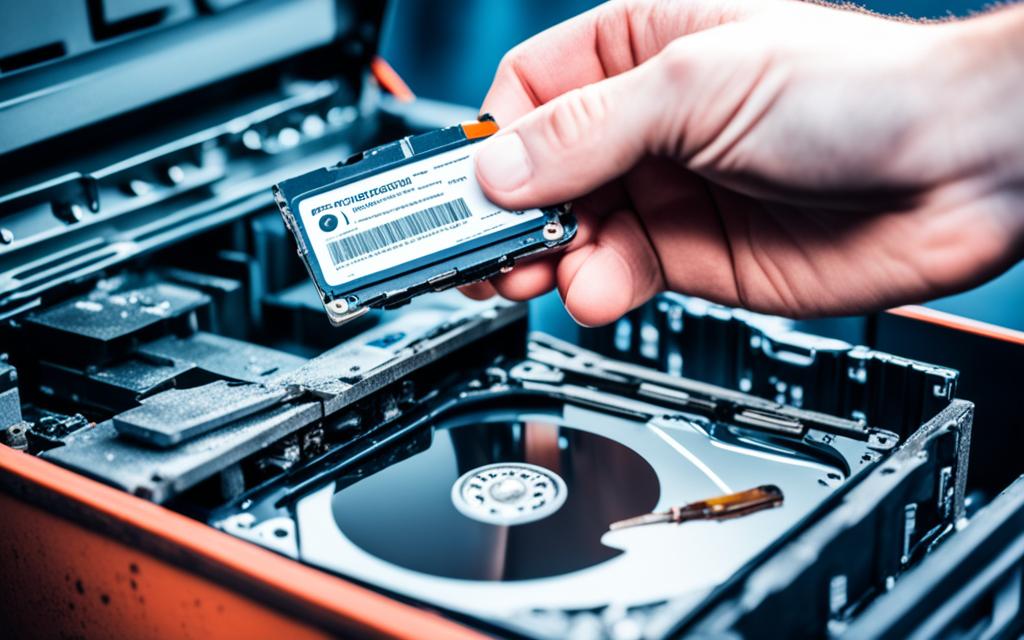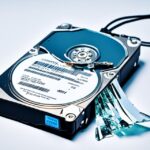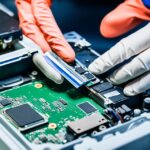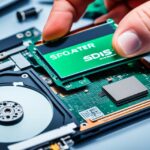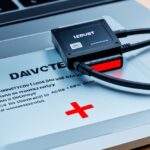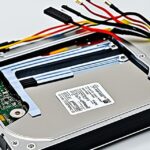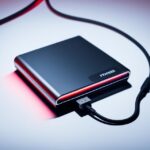Table of Contents
Dropping an external hard drive can lead to severe consequences, especially if it was working during the drop. The impact might cause a range of issues, from minor to severe damage. Trying to turn on a dropped drive right away is risky.
It can make any current problems worse. Knowing the kind of damage is crucial. Without this knowledge, users might accidentally make things worse or lose important data. DIY repairs might seem like a good idea. But without full awareness of the risks, it’s better to seek professional help.
Choosing professional data recovery is often wise to protect valuable data. Being proactive, not just reactive, can save your files and cut down on data recovery costs123.
Key Takeaways
- A dropped external hard drive can suffer varying levels of damage; act quickly to assess the situation.
- Powering on the drive after a drop can lead to further data loss.
- Listen for unusual sounds such as clicking, beeping, or whirring, as these can indicate specific problems.
- Professional data recovery services may be needed, especially if data is irreplaceable.
- DIY repairs are risky and often not recommended due to the potential for further damage.
- Evaluate the condition of your drive before attempting any recovery methods; be cautious.
- Using data recovery software can help, but may have limitations based on the state of the drive.
Understanding the Damage: What Happens When an External Hard Drive is Dropped
When you drop an external hard drive, the damage can be serious, even if it looks okay outside. The parts inside can get knocked out of place, which might cause big problems. It’s crucial to spot the signs early and act to lower the chance of losing your data.
Potential Internal Damage
After falling, the hard drive’s head might crash and hit the platter hard. This often leads to damage that can’t be fixed4. Even a small drop can mess up the inside, causing “Stiction” where the heads get stuck to the platters4. Handling the drive carefully afterwards is very important.
Common Noises Indicating Problems
Noises from a dropped hard drive are bad news. Clicking sounds may mean something’s blocking the drive inside5. A grinding noise is worse, meaning the spindle and platter might be touching. This could mean your data’s in big trouble5. Beeping noises are usually about electronic failures, often from power issues after a drop5.
Long-term Risks of Ignoring Symptoms
Not paying attention to these signs can lead to disaster. If you ignore clicking or beeping, you might lose everything on the drive4. Almost all people try turning their drives back on right after dropping them, which can make things worse6. If you think there’s a problem inside your drive, getting help from a pro is the best move to protect your data.
Important Steps to Take Immediately After Dropping the Drive
Dropping an external hard drive can cause worry. The actions you take next are vital for protecting your data. Following the right data recovery precautions improves your chances of getting your data back. Knowing how to handle your hard drive’s power is key to avoiding more harm.
Avoid Powering On the Drive
After you drop your external hard drive, don’t turn it on. This can make things worse by causing more damage. This is true if the drive has problems inside that you can’t see. There is a small chance of fixing it with Disk Utility after a fall7. If you try to use the drive and the logic board is hurt2, it might stop working completely. That’s why checking the drive carefully before you use it again is very important.
Assessing the Exterior Condition
Make sure the drive is off, then look at its outside. Check for cracks, parts that aren’t attached well, or anything odd. Doing this examination helps you figure out if it can be fixed or needs an expert right away. Seeing the damage can tell you about the drive’s hard drive power management and if any mechanical problems happened when it dropped. Not paying attention to these signs can reduce your chances of getting your data back later7.
How to Repair External Hard Drive After It Was Dropped
After dropping an external hard drive, the first step is to carefully check it. You should start with a full check-up to see what’s wrong. Listen for any strange noises from the drive, as they hint at issues inside.
Diagnosis: Identifying Specific Issues
Right after your hard drive falls, checking it carefully is key. If you hear clicking, it could mean major problems that may prevent data recovery. Beeping might show a serious issue called “stiction,” risking even more data loss4. A drive that spins but doesn’t connect suggests issues with its system or firmware, making things worse.
Clicking and Beeping Sounds: What They Mean
Knowing the sounds your hard drive makes after a fall is crucial. Clicks might mean mechanical failure; beeps suggest deeper problems like stiction. It’s vital to handle it carefully to avoid losing your data forever4.
Professional Recovery vs. DIY Repairs
Deciding between fixing it yourself or getting professional help is tough. DIY might save money, but it’s risky without the right skills. Professionals charge more, starting at $1000, but can successfully get back up to 96% of your data5. For precious data, paying for experts may be the better choice.
| Service | Estimated Cost | Success Rate |
|---|---|---|
| Professional Data Recovery | Starting at $1000 | Up to 96% |
| DIY Repair Supplies | Varies | Dependent on user skill |
| Data Recovery Utility | Free or minimal | Variable based on situation |
If you’re thinking about a professional fix but need more info, help is available. Check out experts who can offer advice and745.
Tools and Resources Needed for Repair
Getting ready for DIY hard drive repairs? Make sure you’ve got the right tools first. These include precision screwdrivers and specialized gear for getting data back. It’s key to have everything you need to make the fix a success.
Essential Tools for Opening the Drive
To open an external hard drive without issues, you need some specific tools:
- Precision Screwdrivers: You’ll need various sizes, like Torx and Phillips, to get into the drive’s shell.
- Tweezers: These are crucial for grabbing tiny parts or screws that are tough to handle.
- Head Combs: They help handle the fragile read/write heads safely.
- Static-Free Bags: Perfect for keeping sensitive parts safe from static damage.
- Cleaning Kits: They ensure the storage areas are clean, preventing further problems.
Purchasing Repair Kits and Equipment
Buying a complete repair kit is a smart move for DIY hard drive repair tasks. These kits come with everything needed, plus more tools for data rescue. You can find kits designed just for external drives at many retailers. This way, you won’t have to pause your work to find a missing tool, saving time and money. Although these kits might seem pricey at first, they’re often more economical than paying for a professional’s help, especially when repairs can get costly8.
Performing Basic Repairs: A Step-by-Step Guide
When you drop an external hard drive, fixing it needs careful steps. It’s important to be systematic so as not to make things worse. This guide will show you how to get to the parts inside and check their state.
Opening the Drive Safely
Firstly, opening the drive safely is key. Use the right tools and don’t force it open.
Inspecting the Read/Write Heads
Once open, look at the hard drive head closely. Check for damage or dirt because these problems could stop you from getting your data back. If you spot any harm, gently clean it off with a cloth that doesn’t leave bits behind.
Dealing with Media Damage
Looking at the platters for scratches is next. Little marks can make getting data back harder. If it’s bad, using a professional service is best to avoid losing more data.
| Repair Method | Description |
|---|---|
| Basic Clean | Inspect and clean the read/write heads carefully. |
| Media Assessment | Evaluate platters for physical damage and assess recovery options. |
| Consult Professional | Seek assistance from certified recovery specialists if the damage is severe. |
| Use Recovery Software | Employ trusted recovery tools to attempt data retrieval, prioritising reliability. |
For deeper insights into recovery options, including software, check out a thorough repair guide. This can help keep your data safe9.
By paying close attention to these steps, you can fix your drive more confidently. This raises your chances of getting your data back.
Conclusion
After dropping an external hard drive, fixing it needs careful thought. Look for signs like clicking or beeping noises10. These could mean the inside parts, like platters or motors, are damaged. Before you try to fix it yourself, think about how bad the damage is11.
Using experts for data recovery might cost more but boosts the chance to get your files back12. To avoid future trouble, back up your data often. Store it on other devices or online to keep it safe.
Whether you fix it yourself or get help, be patient and careful. Making smart choices can help fix your drive and bring it back to life. If you’re interested in learning how to reset your PC, check out this useful guide.
FAQ
What should I do immediately after dropping my external hard drive?
Don’t turn on your drive after dropping it. This can make things worse. Make sure to switch off the device. Check it for any visible signs of harm. This helps you figure out what to do next.
What types of internal damage can occur when an external hard drive is dropped?
A dropped hard drive might have its inside parts knocked out of place. You might not see the damage outside. But, it could cause the hard drive to fail or lose data. It’s important to deal with it quickly.
What noises should I be concerned about if my dropped hard drive is making sounds?
Be wary if your hard drive starts making noises. Clicking sounds can mean issues with the reading parts. Grinding noises may show damage to the disk. Beeping suggests electrical problems. These noises signal that repairs are needed.
Is it safe to attempt DIY repairs on my hard drive?
Trying to fix the drive yourself might be tempting but it’s risky. If you’re not sure what you’re doing, you could make the problem worse. You might even lose your data forever.
What tools do I need to repair an external hard drive?
You will need very fine screwdrivers, tweezers, and special gear. A head comb is good for handling the sensitive parts. Buying a repair kit gets you all these tools in one go.
How can I effectively assess the condition of my hard drive after a drop?
First, look over the hard drive’s outside for damage or parts that are loose. This quick check tells you if you can fix the drive. It also helps you plan your next move.
What is the best course of action for data recovery from a dropped hard drive?
Start by working out the exact problems. Think about if you should call in experts or try to fix it yourself. Acting fast improves your chances of getting your data back.
Why is it important to regularly back up my data?
Backing up data regularly is vital. It shields you from data loss if the drive fails. If you have a backup, you can still get to your important info after an accident.
Source Links
- https://datarecovery.com/rd/dropping-external-hard-drive/ – What To Do After Dropping An External Hard Drive – Datarecovery.com
- https://superuser.com/questions/387459/how-to-repair-or-recover-data-from-a-dropped-portable-external-hard-drive – How to repair or recover data from a dropped portable external hard drive
- https://7datarecovery.com/blog/dropped-hard-drive-recovery/ – How to Repair Dropped External Hard Drive and Recover Data
- https://www.fivestardatarecovery.com/how-to-repair-external-hard-drive-after-it-was-dropped/ – How To Repair An External Hard Drive After It Was Dropped?
- https://www.salvagedata.com/dropped-hard-drive/ – Dropped Hard Drive: What to do to save your data – SalvageData
- https://www.fields-data-recovery.co.uk/blog/dropped-your-hard-drive–here—s-why-it—s-stopped-working – Dropped your hard drive? Here’s why it’s stopped working
- https://discussions.apple.com/thread/3186141 – Help! I dropped my external HD and now my…
- https://www.diskgenius.com/resource/external-hard-drive-repair.html – FREE External Hard Drive Repair Tool to Fix Corrupted External HDD
- https://www.easeus.com/storage-media-recovery/repair-corrupted-external-hard-drive.html – How to Fix Corrupted External Hard Drive Without Losing Data
- https://www.ubackup.com/data-recovery-disk/dropped-external-hard-drive-recovery-0044-rc.html – Dropped External Hard Drive Recovery and Repair Guide
- https://www.ifixit.com/Guide/How To Repair A Dropped External Hard Drive/165405 – How To Repair A Dropped External Hard Drive
- https://www.cleverfiles.com/howto/repair-corrupted-external-hard-drive.html – Repair Corrupted External Hard Drive Without Losing Data

